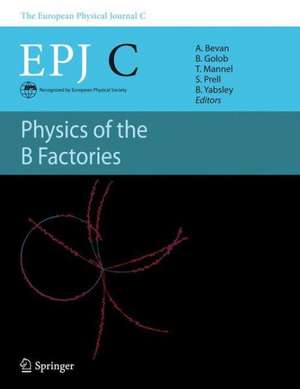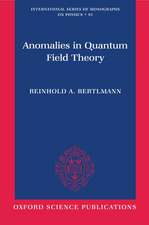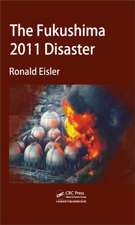The Physics of the B Factories
Editat de Adrian Bevan, Bostjan Golob, Thomas Mannel, Soeren Prell, Bruce Yabsleyen Limba Engleză Hardback – 22 mar 2015
The world’s two giant B Factory collaborations, Belle at KEK and BaBar at SLAC, have successfully completed their main mission to discover and quantify CP violation in the decays of B mesons. CP violation is a necessary requirement to distinguish unambiguously between matter and antimatter. The shared primary objective of the two B Factory experiments was to determine the shape of the so-called unitarity triangle, an abstract triangle representing interactions of quarks, the elementary constituents of matter. The area of the triangle is a measure of the amount of CP violation associated with the weak force.
Many other measurements have been performed by the B Factories and are also discussed in this work.
| Toate formatele și edițiile | Preț | Express |
|---|---|---|
| Paperback (1) | 490.83 lei 6-8 săpt. | |
| Springer Berlin, Heidelberg – 11 oct 2016 | 490.83 lei 6-8 săpt. | |
| Hardback (1) | 503.74 lei 3-5 săpt. | |
| Springer Berlin, Heidelberg – 22 mar 2015 | 503.74 lei 3-5 săpt. |
Preț: 503.74 lei
Nou
Puncte Express: 756
Preț estimativ în valută:
96.39€ • 100.65$ • 79.60£
96.39€ • 100.65$ • 79.60£
Carte disponibilă
Livrare economică 25 martie-08 aprilie
Preluare comenzi: 021 569.72.76
Specificații
ISBN-13: 9783662449905
ISBN-10: 3662449900
Pagini: 900
Ilustrații: XXII, 910 p. 595 illus., 367 illus. in color.
Dimensiuni: 210 x 279 x 55 mm
Greutate: 2.36 kg
Ediția:2015
Editura: Springer Berlin, Heidelberg
Colecția Springer
Locul publicării:Berlin, Heidelberg, Germany
ISBN-10: 3662449900
Pagini: 900
Ilustrații: XXII, 910 p. 595 illus., 367 illus. in color.
Dimensiuni: 210 x 279 x 55 mm
Greutate: 2.36 kg
Ediția:2015
Editura: Springer Berlin, Heidelberg
Colecția Springer
Locul publicării:Berlin, Heidelberg, Germany
Public țintă
ResearchCuprins
Part I The Facilities.- The B Factories.- The Detectors and Collaborations.- Datataking and Monte Carlo Production summary.- Part II Tools and Methods.- Vertexing.- Analysis optimization.- Particle identification.- Flavor tagging.- Background discrimination.- B-meson reconstruction.- Mixing and time-dependent analysis.- Maximum likelihood fitting.- Angular analysis.- Dalitz analysis.- Blind analysis.- Systematic error estimation.- Part III The Results and their Interpretation.- The CKM matrix and the Kobayashi-Maskawa mechanism.- B-physics.- Quarkonium physics.- Charm physics.- Tau physics.- QED and initial state radiation studies.- Two-photon physics.- Y(5S) physics.- QCD-related physics.- Global interpretation.- Glossary.- Index.
Textul de pe ultima copertă
This comprehensive work thoroughly introduces and reviews the set of results from Belle and BaBar - after more than two decades of independent and complementary work - all the way from the detectors and the analysis tools used, up to the physics results, and the interpretation of these results.
The world’s two giant B Factory collaborations, Belle at KEK and BaBar at SLAC, have successfully completed their main mission to discover and quantify CP violation in the decays of B mesons. CP violation is a necessary requirement to distinguish unambiguously between matter and antimatter. The shared primary objective of the two B Factory experiments was to determine the shape of the so-called unitarity triangle, an abstract triangle representing interactions of quarks, the elementary constituents of matter. The area of the triangle is a measure of the amount of CP violation associated with the weak force.
Many other measurements have been performed by the B Factories and are also discussed in this work.
The world’s two giant B Factory collaborations, Belle at KEK and BaBar at SLAC, have successfully completed their main mission to discover and quantify CP violation in the decays of B mesons. CP violation is a necessary requirement to distinguish unambiguously between matter and antimatter. The shared primary objective of the two B Factory experiments was to determine the shape of the so-called unitarity triangle, an abstract triangle representing interactions of quarks, the elementary constituents of matter. The area of the triangle is a measure of the amount of CP violation associated with the weak force.
Many other measurements have been performed by the B Factories and are also discussed in this work.
Caracteristici
Includes supplementary material: sn.pub/extras












